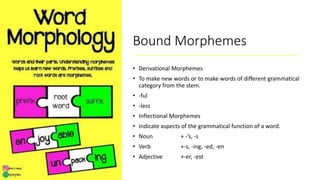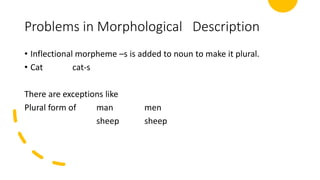Morphology
- 2. MORPHOLOGY âĒ Investigating basic forms in a language is called morphology. âĒ Nitakupenda âĒ I will love you.
- 3. MORPHEMES The definition of a morpheme is "a minimal unit of meaning or grammatical function.
- 4. Free Morphemes That can stand by themselves as single words. New Tour
- 5. Bound Morphemes Can not stand alone and attached to another form. Re- re-new-ed -ist tour-ist -ed walk-ed
- 6. Lexical Morphemes IT IS THOUGHT ÂŦOPEN CLASSÂŧ MORPHEMES. WE CAN CREATE NEW WORDS. EXAMPLES: GIRL, MAN, HOUSE, TIGER, SAD.
- 7. Functional Morphemes It is thought ÂŦclosed classÂŧ morphemes. We almost never add new functional morphemes to language. Conjunctions, prepositions, articles, and pronouns.
- 8. Bound Morphemes âĒ Derivational Morphemes âĒ To make new words or to make words of different grammatical category from the stem. âĒ -ful âĒ -less âĒ Inflectional Morphemes âĒ Indicate aspects of the grammatical function of a word. âĒ Noun + -âs, -s âĒ Verb +-s, -ing, -ed, -en âĒ Adjective +-er, -est
- 10. Inflectional Morphemes âĒ Jimâs two sisters are really different. âĒ One likes to have fun and is always laughing. âĒ The other liked to read as a child and has always taken things seriously. âĒ One is the loudest person in the house and the other is quieter than a mouse.
- 11. âĒ There is an order in usage of derivational and inflectional morphemes. âĒ First derivational morpheme is added. âĒ Teach-er Than inflectional morpheme is added. teacher-s
- 12. Problems in Morphological Description âĒ Inflectional morpheme âs is added to noun to make it plural. âĒ Cat cat-s There are exceptions like Plural form of man men sheep sheep
- 13. âĒ 1 What are the functional morphemes in the following sentence? âĒ When she walked into the room, the doctor asked me if I had a sore throat or an annoying cough.
- 14. 2 âĒ (i) List the bound morphemes in these words: fearlessly, happier, misleads, previewer, shortening, unreconstructed
- 15. âĒ (ii) Which of these words has a bound stem: âĒ consist(it has the meaning "remain; stand; stay. '' This meaning is found in such words as: assist, consist, desist, inconsistent, insist, irresistible, persist, resist, subsist, subsistence.) âĒ Deceit ive, used with the meaning âagainâ or âagain and againâ to indicate repetition, or with the meaning âbackâ or âbackwardâ âĒ Introduce, intro occasionally used in the formation of new words âĒ Repeat, used with the meaning âagainâ or âagain and againâ to indicate repetition, or with the meaning âbackâ or âbackwardâ
- 16. âĒ (iii) Which of these words contains an allomorph of the morpheme âpast tenseâ: are, have, must, sitting, waits? âĒ Are were âĒ Have had âĒ Sitting sat âĒ Waits waited
- 17. âĒ 3 What are the inïŽectional morphemes in these expressions? âĒ (a) Have you eaten yet? âĒ (b) Do you know how long Iâve been waiting? âĒ (c) Sheâs younger than me and always dresses in the latest style. âĒ (d) We looked through my grandmotherâs old photo albums. âĒ (e) My parentsâ parents were all from Scotland.
- 18. 4 What are the allomorphs of the morpheme âpluralâ in this set of English words? âĒ Criteria - Criterion âĒ Dogs - Dog âĒ Oxen - Ox âĒ Deer - Deer âĒ Judges - Judge âĒ Stimulus - Stimuli
- 19. 5 In Indonesian, the singular form translating âchildâ is anak and the plural form (âchildrenâ) is anakanak. What is the term used to describe this relationship? The process involved here is technically known as reduplication (=repeating all or part of a form).
- 20. Provide equivalent forms, in the languages listed, for the English translations shown on the right below. âĒ Ganda omuloÅgo (âtwinâ) â (âtwinsâ) abaloÅgo âĒ Ilocano tawtawa (âwindowsâ) â (âwindowâ) tawa âĒ Ilocano talon (âïŽeldâ) â (âïŽeldsâ) taltalon âĒ Kanuri nÉmkÉji (âsweetnessâ) â (âsweetâ) kÉji âĒ Tagalog bili (âbuyâ) â (âwill buyâ) bibili âĒ Tagalog kain (âeatâ) â (âEat!â) kumain!
- 21. What are enclitics and proclitics? Does English have both? What are some typical English examples? Why arenât they just called afïŽxes? âĒ In English morphology and phonology, a clitic is a word or part of a word that is structurally dependent on a neighboring word (its host) and cannot stand on its own. âĒ they are attached at the end as enclitics: she's (she is or she has), don't (do not). Occasionally they are proclitics: d'you (do you), 'tis (it is). âĒ A clitic is said to be "phonologically bound," which means that it's pronounced, with very little emphasis, as if it were affixed to an adjacent word.





















